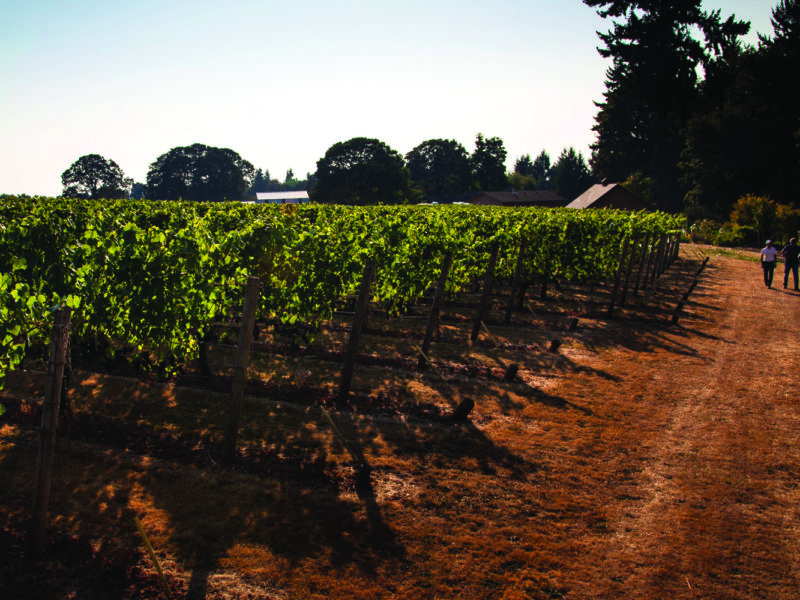
By Gary Twining
The formation and evolution of vineyard soils reflect a major geological struggle that can contribute significantly to the quality of wine grown in those soils. The history of Oregon’s Willamette Valley is one such battle that has enhanced its winemakers’ quest for superb wines.
Oregon is part of a Pacific basin known as the “Ring of Fire.” This horseshoe-shaped area starts near New Zealand, follows northwest along the east coast of Asia, across the Bering Strait, comes south down North America’s west coast and extends to the tip of South America. Home to 75 percent of the world’s active volcanoes and 90 percent of the world’s earthquakes, this Ring of Fire is where the most violent changes in geology have occurred. And it is primarily responsible for the diversity of the Willamette Valley’s soil types.
About 200 million years ago, Oregon’s marine sedimentary soils were formed when the Willamette was covered by the ocean. They are light-colored, well-drained soils over sandstone/siltstone, and their low fertility forces grapevines to send their roots deep for nutrients and water. The flavor characteristics this soil gives to Pinot Noir are black fruits and dark spice notes.
From 16 to 10 million years ago, as the Pacific plate shifted, volcanic activity formed the coastal ranges and completely raised Oregon from beneath the ocean. The early part of this period saw the formation of basalt bedrock that later weathered into the volcanic soils. Even poorer in fertility, with more depth than marine sedimentary soils, their high clay and iron content gives them a reddish hue. These soils impart red fruits, density and earthy flavors to Pinot Noirs.
About 2 1/2 million years ago, the Ice Age glaciers ground down rocks which also weathered into soil. Known as loess, it fed into streams and was wind-blown onto the hillsides, primarily in the northern Willamette. Well-drained loess over basalt bedrock creates vine stress and complexity in the wines.
About 18,000 years ago, Montana’s glacial Lake Missoula’s ice dam would sporadically break, sending a 300-foot wall of water through Washington, the Columbia Gorge and the Willamette, depositing loam, which is a nutrient-rich soil.
Here’s a list of Oregon’s sub-regions, listing the type of soil and what Pinot Noir characteristics that soil imparts:
Dundee Hills: The volcanic-based soils and warmer location between the Coast Ranges and Chehalem Mountains offer Pinot Noirs with bright, elegant raspberry, black cherry/cola/spice fruit, hints of earth and truffle with silky textures.
Eola-Amity Hills: Shallow volcanic soils result in fuller wines with firm acidity, blackberry, black cherry and plum notes. The Van Duzer Corridor, a break in the coastal ranges, encourages cooling ocean breezes in the afternoon and maintains acidity in the fruit.
Chehalem Mountains: A wide range of Pinot styles, from lightly red-fruited, elegant and balanced (cool years) wines to black-fruited, earthy and highly structured wines (warmer vintages). Soils found are marine sedimentary, volcanic and loess.
Yamhill-Carlton: Well-drained marine sediments lead to deep colors, spice and broad tannins, with powerful fruit aromas and minerality.
McMinnville: Marine sedimentary, bedrock and volcanic soils give structured, dark-hued Pinot Noirs with black fruit and earth. Firm acidity from the Van Duzer corridor-cooled ocean winds.
Ribbon Ridge: This region is lower in elevation and warmer than the other appellations, with all marine sedimentary soils that give the wines black fruit, rose petal, spice, a moderate/firm structure, and good acid and extraction.
Celebrate Oregon Pinot Noirs and their diversity of flavors derived from geology’s influences.
Thank you to Medina’s Ronald Fabich, president of the Ohio Earth Science Teachers Association, for his inspiration and technical expertise.


Very useful thank you